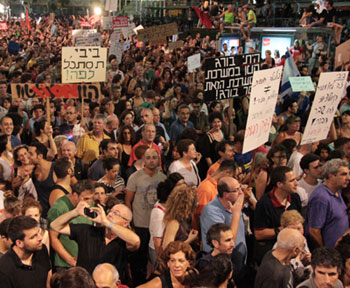

Vol. 75/No. 31 September 5, 2011

|
| Gerrit De Vynck |
| A quarter million demonstrate August 6 in Tel Aviv, Israel, against high cost of living. |
Beginning in mid-July as a small tent protest in downtown Tel Aviv against rising rents, the actions quickly grew and spread to other cities, involving both Jews and Arabs.
On August 6 more than 300,000 took to the streets across Israel, including a quarter million in Tel Aviv, according to the Jerusalem Post. They demanded affordable housing, as well as lower prices, tax relief, and more child care.
The following Saturday, August 13, protest leaders organized actions in 18 smaller cities, not in Tel Aviv or Jerusalem, in order to highlight the spread of the protests. An estimated 50,000 to 70,000 people turned out in all.
The largest August 13 action was in the northern port city of Haifa, where more than 20,000 participated, according to the Jerusalem Post. Many were Arabs, who comprise 20 percent of Israel’s population. Speakers addressed the crowd in Hebrew and Arabic.
More than 10,000 rallied in the southern city of Beersheba. Among the demands there was an end to state demolition of “unrecognized villages” where tens of thousands of Arabs live, reported the New York Times. Other actions occurred in Afula, Ashkelon, Dimona, Eilat, Nahariya, Netanya, and Tikva.
Facing falling support for his government, Prime Minister Benjamin Netanyahu seized on shootings and bombings near Eilat in southern Israel on August 18 to try to quell the protests with nationalist appeals to the country’s Jewish majority for “unity.” Six civilians and two Israeli soldiers were killed in the attacks, which no one claimed responsibility for but Tel Aviv ascribes to the Popular Resistance Committees.
Over the next few days, the Israeli government launched airstrikes along the Egyptian border and in Gaza, and the Popular Resistance Committees and Hamas fired rockets into Israeli towns.
While protests against the high cost of living subsided after the attacks, some organizers say they will keep pressing their demands. The National Union of Israeli Students, for example, called off a rally set for Jerusalem August 20. But Lilach Meir of the group’s department of foreign affairs told the Militant in a phone interview that “We will continue with demonstrations to achieve our demands. Everything here is more expensive. It’s very hard to live.”
Some 4,000 demonstrators joined a silent candlelight march in Tel Aviv August 20. “Many of the marchers said they had turned out not only to be heard on social issues but also to express solidarity with residents in the south,” reported Haaretz. A sharp exchange ensued when some demonstrators raised demands in support of Palestinians in areas occupied by Israel since the 1967 Arab-Israeli war.
‘System is not working’
While the official unemployment rate in Israel is nearly 7 percent, about 40 percent of Israelis between 15 and 64 years old are not working, according to Organization of Economic Cooperation and Development figures. Almost one-quarter of the population lives below the government’s poverty line; for Arabs living in Israel the figure is more than 50 percent. Housing prices have increased about 40 percent in the last three years, according to Bloomberg News.
Protests against these conditions began July 14 after Daphni Leef, a 25-year-old Israeli film school graduate, announced on the Internet that her new home would be a tent in central Tel Aviv along the city’s fashionable Rothschild Boulevard. She invited others to join her. Leef had received an eviction notice and couldn’t afford the higher rent her landlord was demanding. By the end of the week some 5,000 people had moved into tents there and across Israel, she said.
“I am a teacher but with my salary I cannot even finish the month without going into debt,” Adi Peleu, 30, who took up residence in one of these tents in Tel Aviv, told the Financial Times. “The system is not working for us. It’s not just about housing but also about taxes, which are very high; it is about gasoline, which is very expensive, and about the cost of food.”
Signs in both Arabic and Hebrew on a tent titled “48” (short for the year 1948, when the state of Israel was founded) created quite a “buzz” when it was set up in the heart of Tel Aviv, reported dailykos.com. Mixed Arab-Jewish tents have been set up in the Jaffna section of Tel Aviv, and in northern Galilee a mixed Orthodox Jewish and Arab site was erected, according to Al Jazeera.
Hundreds of retirees on pensions rallied by one of the busiest traffic intersections in Tel Aviv August 15. A “stroller march,” demanding the government provide free public child care starting at three months instead of three years of age, took place July 28 in Tel Aviv.
Six days later thousands of dairy farmers marched through the central part of the city protesting government plans to lower the price they would get for their milk and increase imports of dairy products, reported Haaretz.
In face of the protests, Netanyahu called on city officials not to evict the tent campers. Hoping to appease demonstrators and buffer the destabilizing impact on his cabinet, the prime minister set up a government panel to come up with “solutions that are economically sound.”
The committee is supposed to submit its recommendations in September.
Related articles:
Rebel forces take Tripoli in Libyan civil war
Protesters in Syria defy murderous regime
Israel not exempt from class politics
Front page (for this issue) |
Home |
Text-version home